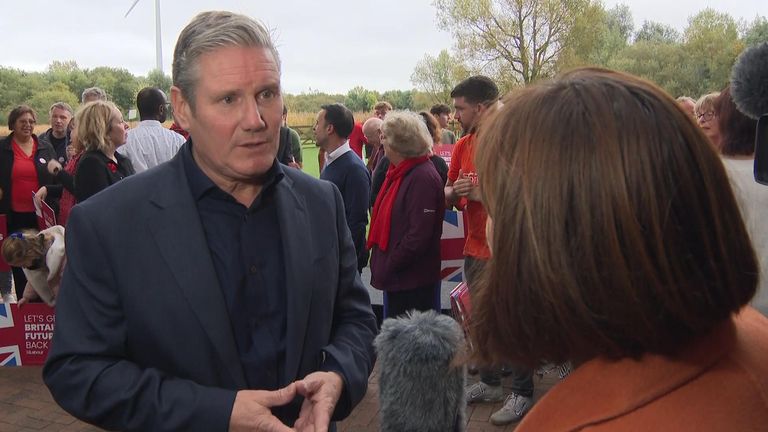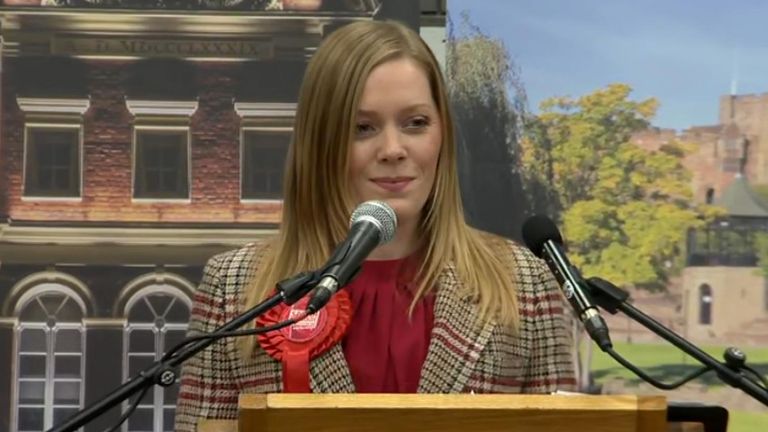Adam Boulton: Double by-election defeat leaves Tories asking is this a re-run of 1992 or 1997? | Politics News
Voters in Tamworth and Mid Bedfordshire have just given a resounding answer to the question obsessing Westminster watchers all year:
“Does the run-in to the next general election feel more like the approach to the 1992 or the 1997 election?”.
This is really the political nerds’ version of the basic question of interest to most of us:
“Is there going to be a change of government?” or, more bluntly still, “Are the Conservatives going to lose?”.
More on the 1992 false dawn for Neil Kinnock’s Labour Party later in this article.
Politics live: Leaked WhatsApp messages reveal Tory dismay
First look at the developing similarities in the parliamentary by-election records from 2019 to the present day and 1992-1997, when John Major’s full term ended with the Labour landslide led by Tony Blair.
A lot of the comparisons are statistical. There is also a mirror image similarity in that both eras witnessed a collapse in both the morale and the morals of the ruling Conservative Party.
Among other issues, this can be seen in the quality of the candidates they are putting forward today.
It is of course the luck of the draw which seats fall vacant between elections.
But as the number of by-elections mounts over a typical four or five-year parliamentary term, a comparable list typically emerges.
Ghosts of elections passed
For example, by a quirk of fate, the last by-election in the Tamworth constituency was in December 1995.
Labour captured South-East Staffordshire, as it was then named, with a swing from the Conservatives of 22.1%.
On Thursday night Labour gained Tamworth with a record swing of 23.9%.
Tamworth and Mid Beds were the eighteenth and nineteenth by-elections this parliament. Of those 10 seats changed hands between parties.
The Conservatives lost eight of them, four to Labour and four to the Liberal Democrats.
Labour also won Rutherglen and Hamilton from the SNP earlier this month and the Conservatives took the “classic red wall” constituency of Hartlepool off Labour at the height of Boris Johnson’s premiership in early 2021.
A lot has changed since then.
There were seventeen by-elections in Great Britain in the 1992-1997 parliament, eight won by another party.
The Conservatives lost all of these, four to the Liberal Democrats, three to Labour, including SE Staffs, and one, Perth and Kinross, to the SNP.
Labour, the main opposition party, seems to be doing better in this cycle than it did a generation ago, in spite of the popularity of the leader then, Tony Blair, far exceeding the ratings of Sir Keir Starmer today.
Back then the Liberal Democrats won more seats than Labour. This time they are behind 5-4, having lost their challenge to Labour in the three-way Mid Beds battlefield, which they claimed was ideal Lib Dem by-election territory.
The Lib Dems were also down to 1.6% in Tamworth, losing their deposit. In the aftermath on Friday morning Daisy Cooper, the ambitious Lib Dem deputy leader, claimed that her party had served Labour by winning over some Conservative voters.
Labour campaigners don’t see it that way.
Read more:
Tory party chair won’t resign despite by-election losses
Sunak puts by-election disasters down to mid-term blues
Starmer cannot afford to be ‘boring’
In the ’92 parliament, four seats changed hands on swings of 20% or more – two Lib Dem and two Labour.
Labour have clocked up three victories on that scale since July.
The by-election results last week suggest that the voters are worried about the cost of living crisis and poor standards of government.
Most seem to have put Brexit to one side. Tamworth, like most of the Midlands, voted heavily to leave the EU.
The Conservatives will also be worried that the Reform Party drained off 3.7% of the votes in Tamworth and 5.4% in Mid Beds.
In each case Reform’s total was bigger than Labour’s new majority.
One option for the Tories would be to try to woo them by shifting to the right.
Unlike the run-up to ’97, when the SNP was stirring, Labour’s support appears to be recovering in Scotland.
This is one of the three reasons why Peter Kellner, the habitually cautious political analyst and founder of YouGov, now anticipates a Labour majority government.
His other pointers are Rishi Sunak’s declining ratings and evidence of anti-Tory tactical voting.
Kellner also concludes that Keir Starmer has overcome the Labour “fear factor”.
YouGov’s data shows that “he has persuaded seven million Tories (out of the 14 million last time) that they have nothing to fear from a Labour government”.
Back to basics – back again?
This is very different from the run-up to 1992, when Conservatives and their allies in the media successfully targeted Labour leader Neil Kinnock and the tax rises proposed in the shadow budget.
After taking over from Margaret Thatcher, John Major won the 1992 election. A few months later on Black Wednesday, 16 September 1982, his government’s economic credibility collapsed.
The Conservatives’ popularity plunged and never recovered. People had been threatened with dramatic increases in the cost of their mortgages.
Meanwhile senior Tories were caught up in a succession of so-called “sleaze’ allegations, some more serious than others, of sexual or financial impropriety.
Following an ill-judged party conference speech by Prime Minister Major theses came to be known under the headline “back to basics”.
Ministers and senior MPs implicated in scandals included David Mellor, Michael Mates, Tim Yeo, Alan Duncan, Michael Brown, Neil Hamilton and Jonathan Aitken.
Since Boris Johnson won his “stonking” general election victory in 2019, the public has been hit by two shocks – one sleazy and one economic.
Both resulted in sustained drops in the Conservative Party’s poll ratings.
Partygate, the revelations of routine flouting of COVID restrictions by Boris Johnson and his staff contributed to his downfall.
Policies introduced by his short-lived successor Liz Truss did lasting damage to the UK economy and household budgets.
Truss was feted at this year’s Conservative Party conference.
Click to subscribe to the Sky News Daily wherever you get your podcasts
Unsuitable candidates
More broadly the Conservatives seem unwilling to respect the common decencies of behaviour, rightly demanded of politicians.
Both the recent by-elections resulted from the personal misconduct of the departing MP: allegations of groping men by Chris Pincher, and Nadine Dorries’ strop over not getting a peerage.
The Tory Party then failed to get a grip on the two candidates who replaced them.
Festus Akimbusoye would have had to resign as local Police and Crime Commissioner if he had won.
To avoid another by-election, the Tories rejected a neighbouring MP, Eddie Hughes, who had already been chosen to fight Tamworth under new boundaries.
His replacement Andrew Cooper, a local councillor and former soldier, was found to have said “f*** off” on social media to benefit claimants with phone or TV subscriptions.
Cooper broke with tradition at the count declaration by leaving the stage before the candidates made their traditional speeches of thanks.
The Conservative strategy in both campaigns was to keep their candidates under wraps and avoid exposing them to the media.
The party is now claiming that the low turnout by voters, which is normal at by-elections, suggests there are masses of Conservative voters who sat at home but will turn out at a general election.
We shall see.
Labour held the three seats it won in by-elections before 1997 until at least 2010.
In contrast the Conservatives won back all seven by-election constituencies they had lost at the subsequent 1992 general election.
There are currently around 16 MPs sitting as independents having lost their party whip.
Eight of them were Labour, including Nick Brown, Jeremy Corbyn and Diane Abbott.
Kier Starmer, the former public prosecutor, has adopted a zero-tolerance stance. If they are not reinstated they will not be able to stand as Labour candidates at the next election.
Standards of behaviour expected of MPs are changing.
Some of the women members standing down have complained of their treatment while in parliament.
Five of the eight successful candidates who snatched by-election victories during this parliament were women.
Meanwhile the proportion of women selected to fight seats for the Conservatives in England is down to less than one in four.
Another by-election?
There is another potential by-election in the offing.
A recall petition will be triggered in Wellingborough if MPs vote to uphold the six-week suspension of Conservative MP Peter Bone recommended by parliament’s Independent Expert Panel for bullying and sexual misconduct.
The outspoken Brexiteer and Johnson-era minister held the Northamptonshire constituency with an 18,540 majority in 2019.
The voting profile is similar to Tamworth’s. It would take a swing of 17.9% for Labour to take it.
This parliament could yet get worse than 1992-1997 for the Conservatives.





